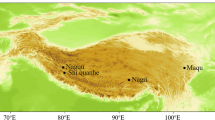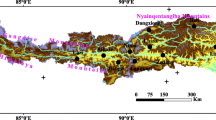Abstract
The changing characteristics of the frozen ground are essential indicators of climate change. The soil temperature on the Tibetan Plateau (TP) during 1987–2018 is simulated using the coupled model of RegCM4.7-CLM4.5. The results show that there is a significant warming trend in the soil temperature on the TP, and the warming trend is higher in October–May (0.040 °C∙decade−1) than in June–September (0.026 °C∙decade−1), with the maximum value in February (0.058 °C∙decade−1). Spatially, the warming is most significant in the Three River Source Region (0.15~0.20 °C∙decade−1) and near the Himalayas and Kunlun Mountains (0.20~25 °C∙decade−1), with the warming trend greater in winter and spring than in summer and autumn. Air temperature, total precipitation, maximum snow depth, and maximum frozen ground depth are all significantly correlated to soil temperature. Air temperature (R = 0.851) and total precipitation (R = 0.411) are positively correlated with soil temperature, while maximum snow depth (R = −0.381) and maximum frozen ground depth (R = −0.770) are negatively correlated with it. Air temperature has a strong influence on the soil temperature in all the four seasons, while the effect of the total precipitation is strongest in autumn (R = 0.836). The retarding effects of maximum snow depth and maximum frozen ground depth are strongest in summer (R = −0.772 and −0.35, respectively). The frozen ground on the TP shows a degradation trend, and the consequent hydrological, ecological, and climatic effects deserve sufficient attention.





Similar content being viewed by others
References
Beheng KD (1994) A parameterization of warm cloud microphysical convection process. Atmos Res 33:193–206
Bian QY, Lyu SH, Wen LJ, Li ZG, Chen SQ (2017) Soil freezing-thawing process and its temperature and moisture conditions in high and low snowfall years in headwaters of the Yellow River. Arid Zone Research 34(4):906–911
Chen J, Sheng Y, Cheng GD (2006) Discussion on protection measures of permafrost under the action of engineering from the point of Earth surface energy balance equation in Qinghai-Tibetan Plateau. J Glaciol Geocryol 28(2):223–228
Cheng GD, Zhao L, Li R et al (2019) Characteristic, changes and impacts of permafrost on Qinghai-Tibet Plateau (in Chinese). Chin Sci Bull 2019(64):2783–2795
Cuo L, Zhang YX, Bohn TJ, Zhao L, Li JL, Liu QM, Zhou BR (2015) Frozen soil degradation and its effects on surface hydrology in the northern Tibetan Plateau. J Geophys Res Atmos 120(16):8276–8298
Emanuel KA (1991) A scheme for representing cumulus convection in large-scale models. J Atmos Sci 48:2313–2335
Fang XW, Luo SQ, Lyu SH (2019a) Observed soil temperature trends associated with climate change in the Tibetan Plateau, 1960–2014. Theor Appl Climatol 135:169–181. https://doi.org/10.1007/s00704-017-2337-9
Fang YP, Zhu FB, Yi SH, Qiu XP, Ding YJ (2019b) Contribution of permafrost to grassland ecological carrying capacity in the Qinghai-Tibetan Plateau. Climate Change Research 15(2):150–157
Fu Q, Hou RJ, Li TX, Jiang RQ, Yan PR, Ma Z, Zhou ZQ (2018) Effects of soil water and heat relationship under various snow cover during freezing-thawing periods in Songnen Plain, China. Sci Rep 8(1):1–12
Gao JQ (2017) Frozen ground response to climate change and the POD-based reduced-order extrapolating model. North China Electric Power University, Beijing, China
Gao R, Wei ZG, Dong WJ et al (2005) Impact of the anomalous thawing in the Tibetan Plateau on summer precipitation in china and its mechanism. Adv Atmos Sci 22(2):238–245
Gao X, Shi Y, Song R, Giorgi F, Wang Y, Zhang D (2008) Reduction of future monsoon precipitation over China: comparison between a high-resolution RCM simulation and the driving GCM. Meteorog Atmos Phys 100:73–86
Gao B, Yang DW, Qin Y, Wang YH, Li HY, Zhang YL, Zhang TJ (2018) Change in frozen soils and its effect on regional hydrology, upper Heihe basin, northeastern Qinghai-Tibetan Plateau. Cryosphere 12(8):657–673
Giorgi F (1990) Simulation of regional climate using a limited area model nested in a general circulation model. J Clim 3:941–963
Giorgi F, Elguindi N, Cozzini S, et al. (2015) Regional climatic model RegCM user’s guide version 4.4. Trieste: Italy.
Guo DL, Wang HJ (2013) Simulation of permafrost and seasonally frozen ground conditions on the Tibetan Plateau, 1981–2010. J Geophys Res-Atmos 118(11):5216–5230
Guo DL, Yang MX, Wang HJ (2011) Characteristics of land surface heat and water exchange under different soil freeze/thaw conditions over the central Tibetan Plateau. Hydrol Process 25(16):2531–2541
Hamed KH, Rao AR (1998) A modified Mann-Kendall trend test for autocorrelated data. J Hydrol 204:182–196
Holtslag AAM, de Bruijn EIF, Pan HL (1990) A high-resolution air mass transformation model for short-range weather forecasting. Mon Weather Rev 118:1561–1575
Kendall MG (1955) Rank correlation methods. Charles Griffin & Co, London
Kong XH, Wang AH, Bi XQ, Wang D (2019) Assessment of temperature extremes in China using RegCM4 and WRF. Adv Atmos Sci 36(4):363–377
Li XL (2013) Study on the relationship between the temporal & spatial of snow cover in winter and spring over Tibetan Plateau and the summer precipitation in Eastern China. Lanzhou University, Lanzhou, Gansu, China
Li X, Jin R, Pan XD, Zhang TJ, Guo JW (2012) Changes in the near-surface soil freeze-thaw cycle on the Qinghai-Tibetan Plateau. Int J Appl Earth Obs Geoinf 17(1):33–42
Li SY, Yang K, Wang CH (2018) Bias characteristics of the land surface model (CLM4.5) over the Tibetan Plateau during soil freezing-thawing period and its causes. Journal of Glaciology and Geocryology, 2018 40(2):322–334
Luo SQ, Fang XW, Lyu SH, Ma D, Chang Y, Song MH, Chen H (2016) Frozen ground temperature trends associated with climate change in the Tibetan Plateau Three River Source Region from 1980 to 2014. Clim Res 67(3):241–255
Luo JX, Lyu SH, Wang T, Liu YG (2020a) Variation characteristics of snow cover and its influence on soil water and heat transfer on the Qinghai-Xizang Plateau. Plateau Meteorology 39(6):1144–1154
Luo SQ, Wang JY, Pomeroy JW, Lyu SH (2020b) Freeze-thaw changes of seasonally frozen ground on the Tibetan Plateau from 1960 to 2014. J Clim 33:9427–9446
Mackay A (2008) Climate Change 2007:Impacts, adaptation, and vulnerability. Contribution of working group II to the fourth assessment report of the intergovernmental panel on climate change. J Environ Qual 37(6):2407
Mann HB (1945) Nonparametric tests against trend. Econometrica 13:245–259
Oleson KW, Lawrence DM, Bonan GD, et al. (2013) Technical description of version 4.5 of the Community Land Model (CLM). Colorado: NCAR.
Qian YF, Zheng YQ, Zhang Y, Miao MQ (2010) Responses of China’s summer monsoon climate to snow anomaly over the Tibetan Plateau. Int J Climatol 23(6):593–613
Sen PK (1968) Estimates of the regression coefficient based on Kendall’s tau. J Am Stat Assoc 63:1379–1389
Serreze MC, Walsh JE, Chapin FS et al (2000) Observational evidence of recent change in the northern high-latitude environment. Clim Chang 46(2):159–207
Wang SJ (2017) Progresses in the variability of snow cover over the Qinghai-Tibetan Plateau and its impact on water resources in China. Plateau Meteorology 36(5):1153–1164. https://doi.org/10.7522/j.issn.1000-0534.2016.00117
Wang CH, Dong WJ, Wei ZG (2001) The feature of seasonally frozen soil in Qinghai-Tibet Plateau. Acta Geograph Sin 56(5):523–531
Wang CH, Dong WJ, Wei ZG (2003) Study on the relationship between the frozen-thaw process in Qinghai-Xizang Plateau and circulation in East-Asia. Chin J Geophys 46(3):309–316
Wang XY, Yi SH, Wu QB et al (2016) The role of permafrost and soil water in distribution of alpine grassland and its NDVI dynamics on the Qinghai-Tibetan Plateau. Glob Planet Chang 147:40–53
Wang R, Zhu QK, Ma H, Ai N (2017) Spatial-temporal variations in near-surface soil freeze-thaw cycles in the source region of the Yellow River during the period 2002–2011 based on the Advanced Microwave Scanning Radiometer for the Earth Observing System (AMSR-E) data. Journal of Arid Land 9(6):850–864
Wang T, Li ZG, Lyu SH (2019) Study on the effects of snow cover on heat transport in the land surface process over Qinghai-Tibetan Plateau. Plateau Meteorology 38(5):920–924. https://doi.org/10.7522/j.issn.1000-0534.2019.00026
Wang CH, Zhao W, Cui Y (2020) Changes in the seasonally frozen ground over the eastern Qinghai-Tibet Plateau in the past 60 years. Front Earth Sci 8:270
Wu QB, Zhang TJ (2010) Changes in active layer thickness over the Qinghai-Tibetan Plateau from 1995 to 2007. J Geophys Res-Atmos 115(9):1–12
Xie ZP, Hu ZY, Liu HL, Sun GH, Yang YX, Lin J, Huang FF (2017) Evaluation of the surface energy exchange simulations of land surface model CLM4.5 in the alpine meadow over the Qinghai-Xizang Plateau. Plateau Meteorology 36(1):1–12. https://doi.org/10.7522/j.issn.1000-0534.2016.00012
Yang K, Wu H, Qin J, Lin CG, Tang WJ, Chen YY (2014) Recent climate changes over the Tibetan Plateau and their impacts on energy and water cycle: a review. Glob Planet Chang 112(1):79–91
Yu L (2011) Simulation study on the characteristics of climate change and over Tibet Plateau. Lanzhou University, Lanzhou, Gansu, China
Zeng X, Zhao M, Dickinson RE (1998) Intercomparison of bulk aerodynamic algorithms for the computation of sea surface fluxes using TOGA COARE and TAO data. J Clim 11:2628–2644
Zhang TJ (2005) Influence of the seasonal snow cover on the ground thermal regime: an overview. Rev Geophys 43(4):RG4002
Zhang YS, Li T, Wang B (2004) Decadal change of the spring snow depth over the Tibetan Plateau: the associated circulation and influence on the East Asian summer monsoon. J Clim 17(14):2780–2793
Zhang T, Wang GX, Yang Y et al (2018) The seasonal variation of ecosystem respiration in different vegetation types in the permafrost regions of Qinghai-Tibet Plateau. J Glaciol Geocryol 40(6):1255–1264
Zhao HX, Moore GWK (2004) On the relationship between Tibetan snow cover, the Tibetan plateau monsoon and the Indian summer monsoon. Geophys Res Lett 31(14):101–111
Zhou JW (2007) Simulation of the effect of anomalous Plateau snow cover and SSTA on summer climate of northwest China. Nanjing University of Information Science & Technology, Nanjing, Jiangsu, China
Zhou YW, Guo DX (1982) Principal characteristics of permafrost in China. J Glaciol Geocryol 4(1):1–12
Acknowledgements
We thank Nanjing Hurricane Translation for reviewing the English language quality of this paper. We are very grateful for the reviewers and the editor for constructive recommendations and advices. We thank ICTP and ECMWF for providing the model (http://clima-dods.ictp.it/Users/ggiulian/) and data (http://clima-dods.ictp.it/regcm4/).
Author Econtribution
Luo analyzed the data and wrote the paper, Lyu guided the research ideas, and Fang and Liu suggested improvements to the research method and program code.
Availability of data and material
The datasets generated and/or analyzed during the current study are available from the corresponding author on reasonable request.
Code availability
No code was developed in the current study.
Funding
This research was jointly supported by the Second Tibetan Plateau Scientific Expedition and Research (STEP) Project (2019QZKK0103), the National Natural Science Foundation of China (Grants 41775016, 41975007, and 41905008), and the Scientific Research Foundation of CUIT (KYTZ201822).
Author information
Authors and Affiliations
Corresponding author
Ethics declarations
Consent to participate and for publication
Authors agree to publish this paper.
Conflict of interest
The authors declare no competing interests.
Additional information
Publisher’s note
Springer Nature remains neutral with regard to jurisdictional claims in published maps and institutional affiliations.
Rights and permissions
About this article
Cite this article
Luo, J., Lyu, S., Fang, X. et al. Trends in the frozen ground temperature on the Tibetan Plateau simulated by RegCM4.7-CLM4.5. Theor Appl Climatol 145, 891–901 (2021). https://doi.org/10.1007/s00704-021-03664-3
Received:
Accepted:
Published:
Issue Date:
DOI: https://doi.org/10.1007/s00704-021-03664-3




